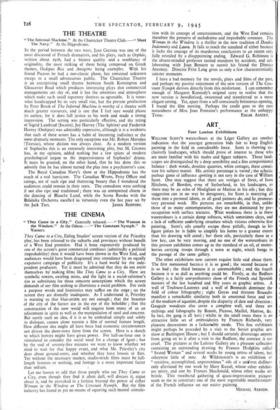THE CINEMA
" They Came to a City." Generally released.—" The Woman in the Window." At the Odeon.—" The Constant Nymph." At Warners.
They Came to a City, Ealing Studios' screen version of the Priestley play, has been released to the suburbs and provinces without benefit of a West End premiere. Had it been expensively produced by one of the screen's great commercial combines (admittedly a political improbability) then it would have been shown in the West End, and audiences would have been dragooned into attendance by an equally expensive campaign of publicity. It's a hard world for the independent producers. Yet it must be admitted that they do not assist themselves by making films like They Came to a City. Here are symbolic towers, swirling mists, and the light in a social reformer's eye as substitutes for those concrete conceptions which the screen demands of any film seeking to illuminate a social, problem. For such a purpose words and histrionics may suffice on the stage ; on the screen they are dismally inadequate. As I understand it, Priesdey is warning us that blue-prints are not enough ; that the beauties of the city of the future are in the eye of the beholder ; that the construction of the new world will require from many of us an adjustment in spirit as well as the manipulation of steel and concrete. But surely such an idea, if it is to be embodied simply and solely in dialogue, cannot alone sustain a film of normal feature length. How different this might all have been had economic circumstances not driven the short-story form from the screen. Here is a sketch to which brevity might have given power. For half-an-hour one is stimulated to consider the social need for a change of Iteart ; but by the end of seventy-five minutes we want to know whether we need to wait for that happy event, and what Mr. Priesdey's city does about ground-rents, and whether they have houses or flats. Yet without the necessary market, studio-made films must be fulllength features or nothing, and footage is a more important factor than tedium.
Let me hasten to add that those people who see They Came to a City, even though they find it often dull, will discuss it, argue about it, and be provoked in a fashion beyond the power of either Woman in the Window or The Constant Nymph. But the film industry has found as yet no means of equating such Inental stimula tion with_its concept of entertainment, and the West End remains therefore the preserve of melodrama ■ and improbable romance. The WOman in the Window is a thriller in the new tradition of Double Indemnity and Laura. It fails to reach the standard of either because it lacks the courage of its murderous conclusions to an extent only fully revealed by a disappointing ending. Edward G. Robinson is the absent-minded professor turned murderer by accident, and collaborating with Joan Bennett to outwit his friend the District Attorney. Director Fritz Lahg gives us only a few characteristically sinister moments.
I have a bad memory for the novels; plays and films of the past, and perhaps my passive enjoyment of the new version of The Con,stant Nymph derives directly from this misfortune. I can remember enough of Margaret Kennedy's original story to realise that the new version is bowdlerised, sweetened and transferred to a more elegant setting. Yet, apart from a self-consciously boisterous opening, I found the film moving. Perhaps the credit goes to the rare naturalness of Miss Joan Fontaine's performance as the unhappy
Tessa.EDGAR ANSTEY.






















 Previous page
Previous page